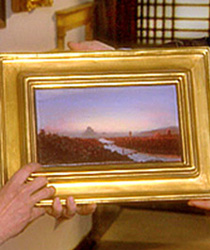Martha Stewart Living
Renee Laker, Bloomfield Hills, Michigan
Q: I found a beautiful painting in an antique store, but I’m not sure how to frame it. I’m planning to take it to a frame shop, but do you have any advice for me on how to make the frame complement the painting?
Eli Wilner & Co. in New York City is one of Martha’s favorite places to select a frame, especially an antique one. Martha thought the best way to answer this question would be to show you a clip from a field trip she took to Eli’s studio in Long Island City. In it, Eli presents several alternatives for framing a still life of a pair of apples painted by E.C. Leavitt in 1895, and also suggests the ultimate frame for a contemporary landscape painting of Florence by Stephen Hannock. In choosing a frame, Eli considers the era in which the painting was made, its colors and what brings them out, the composition, and the amount of detail in the painting. An ornate gilt frame, possibly chosen by the artist himself, best complements the painting of the apples. For the view of Florence, the artist and Eli, working together, have chosen something much more streamlined, the form of which, nonetheless, is suggestive of the 19th century.
Once unappreciated and considered worthless, frames can now greatly enhance a painting’s value — as well as its aesthetic worth. Eli says period frames are essential to understanding and appreciating a painting as the artist originally intended. Some artists carved their own frames, while others worked closely with frame makers to execute their designs. A frame signed by the artisan is often quite valuable. Some notable frame makers and designers include:
Charles Prendergast (1863-1948): An accomplished painter, Prendergast drew inspiration for his frames from the Chinese and Persian collections at Boston’s Museum of Fine Arts. He and his brother, Maurice, are among the most influential 20th-century American frame makers.
Stanford White (1853-1906): Renowned as an architect, Stanford White often designed frames with rich architectural elements that complemented his interiors.
Frederick Harer (1880-1940): A painter, sculptor, etcher, and frame maker from Bucks County, Pennsylvania, he was known for his use of stencils, incising, and burnishing and was greatly influenced by Spanish and West Indian art.


